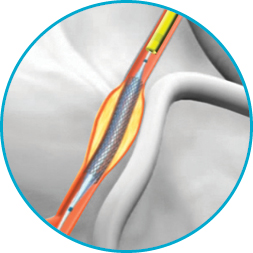

If strong resistance is encountered during manipulation of the devices, do not force passage.Due to the size and the nontapered tip of the guide extension catheter, use extreme care to avoid vessel occlusion and damage to the wall of the vessels.Torquing the device can result in wire wrap or damage to the device or vessel. Do not apply torque to the guide extension catheter during delivery because catheter damage can occur.Perform PTCA only at hospitals where emergency coronary artery bypass graft surgery can be performed in the event of a potentially injurious or life-threatening complication.Use the guide extension catheter before the Use-by date specified on the package.If pressure in a vessel dampens after inserting the guide extension catheter, withdraw the guide extension catheter until the pressure returns to normal. Vessel injury, ischemia, and occlusion can occur. Do not advance the guide extension catheter into a vessel with an effective diameter less than 2.5 mm.Do not advance the guide extension catheter into a vessel without a leading guidewire because vessel damage can occur.Resterilization or reuse can compromise device performance and increase the risk of inadequate resterilization and cross-contamination. For single-patient and single-procedure use only.In vessels in the neurovasculature or the venous system.In vessels less than 2.5 mm in diameter.

The guide extension catheter is contraindicated in the following situations: Telescope™ guide extension catheter is intended to be used in conjunction with guide catheters to access discrete regions of the coronary and/or peripheral vasculature, and to facilitate placement of interventional devices. Interventional cardiologists must be aware of this potential use of the “mother-and-child” technique.Prior to use, refer to the Instructions for Use supplied with these devices for indications, contraindications, side effects, suggested procedure, warning and precautions. The GuideLiner may be a useful adjunct for rotablation when the rotating burr cannot cross a tight, calcified stenosis and more support is needed. It is prudent to avoid large burrs because of the risk of entrapment in the GuideLiner. Caution is needed to position the burr distal to the GuideLiner before starting any forward rotation to avoid potential damage and shear of the “child” catheter. However, its use to deliver the rotablation burr (3) is off-label and has been reported only once (4). The GuideLiner has been previously used to retrieve a trapped rotaburr (2). The GuideLiner is a guide catheter extension used for the “mother-and-child” technique, which improves support through deep intubation of the target vessel and thus facilitates delivery of stents in tortuous or calcified vessels (1). The PCI was completed with standard techniques, with excellent results ( Figure 1C). This maneuver obviously “stiffened” the guide catheter-rotawire-rotablation catheter assembly and enabled the rotating burr to cross the heavily calcified stenosis. We eventually managed to rotablate the calcified stenosis after we advanced a 6-F GuideLiner (“mother-and-child” technique) (Vascular Solutions Inc., Minneapolis, Minnesota) proximal to the stenosis ( Figure 1B, Online Video 3). However, we were initially unable to cross the stenosis with the rotating 1.25-mm burr. We used a left femoral access, a long sheath, and an Amplatz Left 1 guide catheter (Boston Scientific, Natick, Massachusetts) to optimize support. Final result after right coronary artery stent deployment (left anterior oblique view) ( Online Video 3). (C) Right coronary angiogram post rotational atherectomy. Rotaburr crossing the lesion with the support of the GuideLiner (left anterior oblique view) ( Online Video 2). (B) Rotational atherectomy supported by the GuideLiner. Tight calcified stenosis in the midportion of the right coronary artery (left anterior oblique view) ( Online Video 1). (A) Right coronary angiogram pre-rotational atherectomy. GuideLiner-Facilitated Rotational Atherectomy in Calcified Right Coronary Artery

Guideliner download#
Download Figure Download PowerPoint Figure 1.


 0 kommentar(er)
0 kommentar(er)
